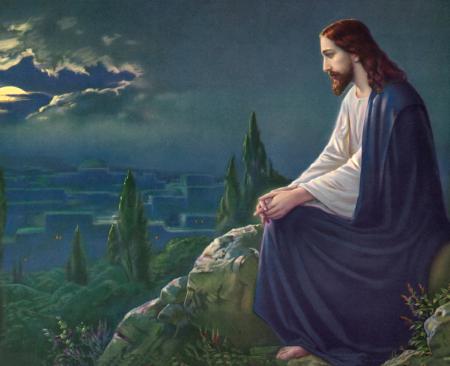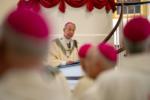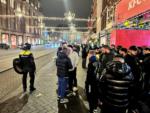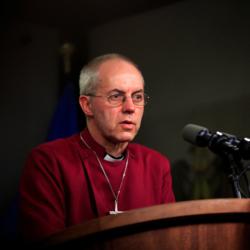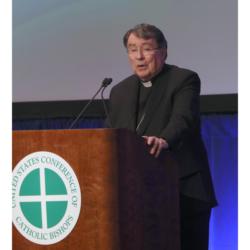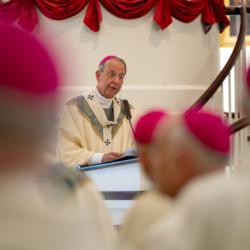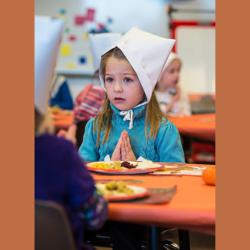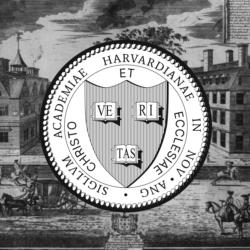'These holy paintings can heal us'
(Following is the text of the prepared remarks addressed by Spanish artist David Lopez to Cardinal O'Malley describing the 1,300 sq. ft. hand-painted altarpiece at St. Thomas Aquinas Church in Jamaica Plain. The cardinal was at the parish for a special Mass to bless the altarpiece and dedicate the church's new altar on June 28, 2024.)
Benedict XVI said that when faith is welcomed, it always generates culture. It becomes culture. It is impossible to encounter Christ and not change our lives. The Risen Christ, victorious over death, presides this altarpiece, presides this church. This is the great news that every man waits for.
Dear cardinal, in 1965, as the council was nearing its end you were professing your first vows as a Capuchin. Today, at the end of your teaching journey, you unveil this work that reflects the council's goals: better participation of the faithful in the mysteries we celebrate and a rediscovery of the centrality of baptismal grace as a source of Christian life.
Seven steps, like seven deadly sins, descend to our deepest reality where we have found Christ: forgiveness, love and mercy. We have all been enemies of Christ, and there we have known him; this is our truth. The early church proclaimed with great force the mystery of our salvation, which is love to the enemy. The beauty of crucified love was the light that converted the Roman empire. Today, the nations abandon faith, and in most European countries, 60, 75, and even 90 percent of the youth declare themselves atheists. Today, only about 30 percent in Boston declare themselves Catholic.
We find ourselves facing a fierce nihilism that invades everything. Harvard and MIT are setting the foundations for the future of humanity. The church cannot be indifferent; artists cannot be indifferent. Together, they always knew how to embody the mysteries of our faith in each generation. The church always responded to the challenges of each era by generating a culture that helped the faithful in their life of faith. This is how we created the Romanesque, the Gothic, baroque, etc.
When Luther arrived, the church responded, at the Council of Trent, by placing the tabernacle at the center, the real presence of Jesus Christ among us. Something never done before. The reserve of the Blessed Sacrament had been in a separate place before. Extraordinary situations call for exceptional measures.
Today, in 2024, with what aesthetics does the church want to evangelize the secularized man of the 21st century, the man of the third millennium? Again, extraordinary needs call for exceptional measures. Today, for the first time in human history, entire nations declare themselves atheists. We cannot continue to let baptism, which means our being Christian, be left in a dusty corner of our churches. Its centrality is fundamental today. "See how they love each other" was the call of the first Christians to faith; it is important to recover the meaning of our assemblies: with his vertical sense (God and man) but also a horizontal one (man with man), "love God and your neighbor," this is the entirety of the law. St. John says, "How can you love God if you hate your brother?"
Modernity has separated science from faith, and science today has replaced faith as the new religion. This great altarpiece presides over our assembly as a pedagogical instrument for catechesis and a help to enter the mysteries that celebrate the action of God in our lives.
Today, there are no Christian artists because there are no Christians. This is why Christian initiation is most urgent; without it, there are no Christian artists.
Just as an image can damage the soul (think of pornography, for instance), these holy paintings can heal us and make us return to original innocence. That is why they will be blessed today, because there is a presence of God in them.
Here is an aesthetic linked to the tradition, in content and colors, but with the discoveries of modern art in forms.
This beautification would not have been possible without you, dear cardinal, without so many of those present here, others not here, and, above all, this work would not have been possible without Kiko Arguello, from whom we have all received so much.
It is not by chance that God chose an artist to carry out the renewal of the council. When the Lord returns, will he find faith on earth? Here is our mission: to pass faith to the next generation. Here is our task and the meaning of all this work.
For the love of the poor and the far away, for those who are victims of prejudice, this house will be the cleft in the rock, the refuge of so many while God's glory passes by. Week after week, we have taught our children that the glory of God is in blessing him, in speaking well of him.
We have been created for a blessing, and we suffer because we cannot bless. Death prevents us; it becomes for us an obstacle. This is our deepest drama. In the face of this drama, God does not remain indifferent and initiates a plan of salvation in his Trinity. In his being relation, community and family, God has created everything in relation; art is relation. Everything is relation, everything in relation, but not relative.
Nature itself is relation. We find in Proverbs that "in nature everything sings the beauty of what is next to it." So, the white color enhances the black the most; it does not oppose him. Red is the color that enhances green the most, etc. The cold helps us value the heat. And so everything, in a relation of love.
What does a man value most? A woman. The more you are woman, the more you value your husband's masculinity and vice versa. This relationship is in function of a blessing, in the service of love. Without hunger, no one could bless the food. Without the night, no one could bless the day, etc. Well, at the center, we see the Trinity. God offers his Son a chalice, to climb the tree, and everything began in the acceptance of this Son.
In the lower level of the icon, we find:
-- The Incarnation. We have all had an announcer and we have all been called to be announcers of the Great News, and Mary, who welcomes this great news: "May it be done to me according to your word."
-- The Nativity, with Mary with her back to the child, who prophesies the rejection that he will suffer from humanity, and Joseph, the image of everyone, of every priest, in his trial: to accept this child who is not his. We find an old sweet shepherd dialoguing with Joseph, but it is the image of the devil that tempts us all to reject this child.
-- Baptism, the heaven closed since the fall of Adam opens to us. Stripping himself naked, Christ agrees to enter into our suffering, into the waters of death.
-- The Crucifixion, a new Adam who makes everything new. The old Adam is below, the skull. Notice that the wound on the side is not yet there, because Christ is still alive, offering us Mary as mother. What an enormous mystery, an enormous exchange!
In the upper level:
-- The Ascension. Christ is going to enter heaven, opening for us a time of work, of fruitfulness, to announce his second coming: "Galileans, why do you look up? Just as you see him rise, he will come with glory."
-- The Dormition (Assumption) image of the death of the Christian. We do not die alone, Mary is surrounded by her community. Her soul is taken first.
All these images are presented to us as an eschatological view, an invitation to look at heaven, our final destination. That's why they are not very realistic, as you can see. Because they are images of another space-time, a transfigured, celestial space-time. Today, nothing offers us an eschatological view. History is coming to an end. At the beginning of the end, we are facing "the last revolution," as Pope Benedict said, questioning not only a fact of our history but its very origin: man and woman he created them. There is no other human revolution while we witness the transfer of decisions to machines in every aspect of our lives.
That ribbon that contains the universe is coming to an end, with the Ark of the Covenant at the center, the presence of the living God and of his glory, which is Mary, the church.
Presiding all this is the Risen Christ who will come, victorious over death, breaking the circle of death that separates us from eternity. In his second coming, all human actions will be judged. And we will understand everything from everyone.
Christ loved us when we were his enemies; He allowed himself to be killed, beaten, insulted, spat on. They laughed and plotted against him; they slandered him; they tortured him. But He offered all of this for all men as a penalty paid for thieves and wicked men, for the sins of all of us.
For this reason, in the open book that Christ, the Pantocrator, holds in the center, it is written: "Love your enemies, I am coming soon!"
We will only be judged according to how we have embraced this total love; nothing else will be asked of us. That is the synthesis of all Christianity, its most radical truth. That's why Christians don't get divorced, they don't take others to court, they let themselves be robbed ... all with the grace of God.
"Deesis" means intercession: at the sides of Christ are Mary and St. John the Baptist, with the holy archangels, who intercede for all of us so that this becomes true in us.
Finally, Peter and Paul, as columns that support the church until the end of time: charism and institution. If I may, you dear cardinal and Kiko ArgÜello, both of you have been courageous seeking paths of love for God and man, without fear.
For my part, I thank the Lord for the grace to be part of this work that I pray may help with the salvation of souls and the New Evangelization of the church. Thank you!
David Lopez is a Spanish contemporary artist who led the team of 12 artists that created the altarpiece at St. Thomas Aquinas Parish in Jamaica Plain. His work has been exhibited in New York and Paris, and he received the Pontifical Academies Prize from Pope Benedict XVI in 2012.
